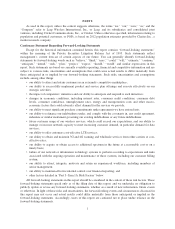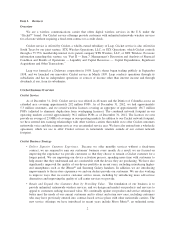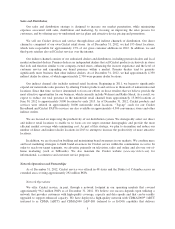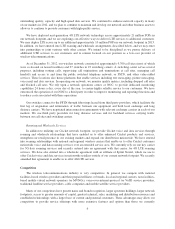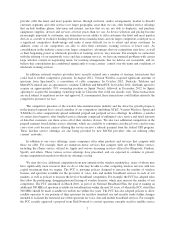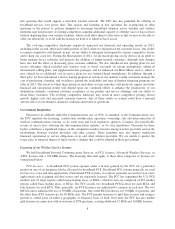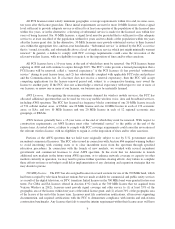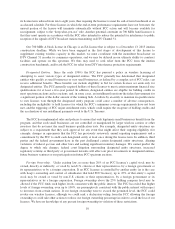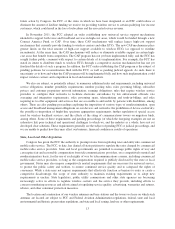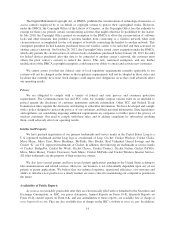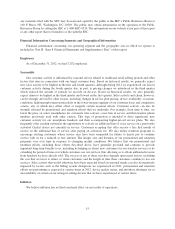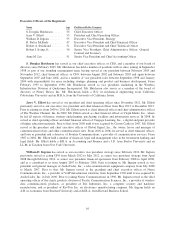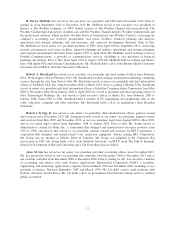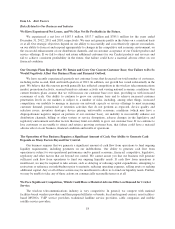Cricket Wireless 2012 Annual Report Download - page 22
Download and view the complete annual report
Please find page 22 of the 2012 Cricket Wireless annual report below. You can navigate through the pages in the report by either clicking on the pages listed below, or by using the keyword search tool below to find specific information within the annual report.into spectrum that would support a terrestrial wireless network. The FCC has also permitted the offering of
broadband services over power lines. The auction and licensing of new spectrum, the re-purposing of other
spectrum or the pursuit of policies designed to encourage broadband adoption across wireline and wireless
platforms may result in new or existing competitors acquiring additional capacity or offering voice or data services
without deploying their own wireless facilities, which could allow them to offer services that we may not be able to
offer cost effectively, or at all, with the licenses we hold or to which we have access.
The evolving competitive landscape negatively impacted our financial and operating results in 2012,
including in the second, third and fourth quarters of 2012 when we experienced net customer losses. Our ability
to remain competitive will depend, in part, on our ability to anticipate and respond to various competitive factors
and to keep our costs low. During the third quarter of 2012, we increased pricing on our devices in an effort to
better manage device subsidies and promote the addition of longer-tenured customers, although such changes
have also had the effect of decreasing gross customer additions. We also introduced new pricing plans for our
service offerings, which included new features such as visual voicemail on certain smartphones, enhanced
international calling plans, and supplemental data packages, and we enhanced our Muve Music service, which is
now offered for no additional cost in service plans for our Android-based smartphones. In addition, through a
third party we have introduced a device leasing program in certain of our markets to help customers manage the
cost of purchasing a handset, and we plan to expand the availability and type of handset financing programs we
offer in 2013. The extent to which these initiatives and others we may introduce will positively impact our future
financial and operational results will depend upon our continued efforts to enhance the productivity of our
distribution channels, continued customer acceptance of our product and service offerings, and our ability to
retain these customers. The evolving competitive landscape may result in more competitive pricing, slower
growth, higher costs and increased customer turnover. Any of these results or actions could have a material
adverse effect on our business, financial condition and results of operations.
Government Regulation
Pursuant to its authority under the Communications Act of 1934, as amended, or the Communications Act,
the FCC regulates the licensing, construction, modification, operation, ownership, sale and interconnection of
wireless communications systems, as do some state and local regulatory agencies. Congress also periodically
revises or enacts laws affecting the telecommunications industry, as do state legislatures. Decisions by these
bodies could have a significant impact on the competitive market structure among wireless providers and on the
relationships between wireless providers and other carriers. These mandates may also impose significant
financial, operational or service obligations on us and other wireless providers. We are unable to predict the
scope, pace or financial impact of legal or policy changes that could be adopted in these proceedings.
Licensing of our Wireless Service Systems
We hold broadband Personal Communications Services, or PCS, licenses, Advanced Wireless Services, or
AWS, licenses and a 700 MHz license. The licensing rules that apply to these three categories of licenses are
summarized below.
PCS Licenses. A broadband PCS system operates under a license granted by the FCC for a particular
market on one of six frequency blocks allocated for broadband PCS. Broadband PCS systems generally are used
for two-way voice and data applications. Narrowband PCS systems, in contrast, generally are used for non-voice
applications such as paging and data service and are separately licensed. The FCC has segmented the U.S. PCS
markets into 51 large regions called major trading areas, or MTAs, which in turn are comprised of 493 smaller
regions called basic trading areas, or BTAs. The FCC awards two broadband PCS licenses for each MTA and
four licenses for each BTA. Thus, generally, six PCS licensees are authorized to compete in each area. The two
MTA licenses authorize the use of 30 MHz of spectrum. One of the BTA licenses is for 30 MHz of spectrum, and
the other three BTA licenses are for 10 MHz each. The FCC permits licensees to split their licenses and assign a
portion to a third party on either a geographic or frequency basis or both. Over time, the FCC has also further
split licenses in connection with re-auctions of PCS spectrum, creating additional 15 MHz and 10 MHz licenses.
8





